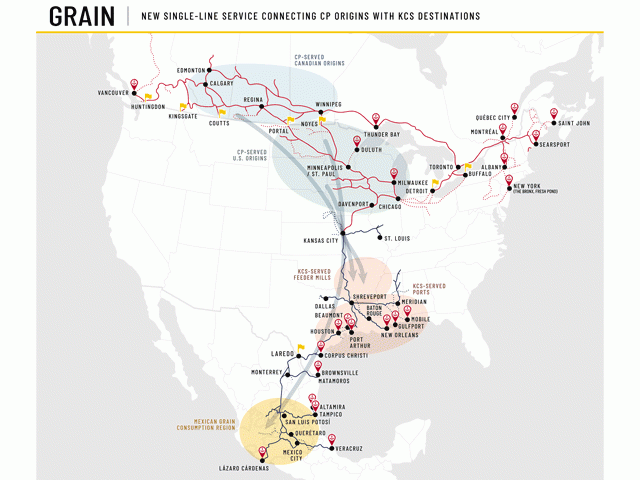Merger May Change Grain Flow
Canadian Pacific Buying Kansas City Southern, Creating a USMCA Railroad
OMAHA (DTN) -- Major crop commodities from Canada and upper Midwest states will have new ways to export through the Gulf of Mexico and into Mexico itself with the announcement Sunday by the Canadian Pacific Railway that it has agreed to buy the Kansas City Southern railroad for $25 billion in value.
The merger will provide direct rail service throughout Canada down to central Mexico and key agricultural and manufacturing hubs through the center of the U.S. Executives from two railroads highlighted the merger would create the first U.S.-Mexico-Canada rail network, furthering the ties of the U.S. Mexico Canada Agreement (USMCA).
Canadian Pacific Railway (CP) agreed to buy Kansas City Southern (KCS) railroad in combined stock and cash for $29 billion, which includes taking $3.8 billion in KCS debt. The combined railroad would be called Canadian Pacific Kansas City (CPKC). Under the deal, Calgary, Alberta, would be the global headquarters while Kansas City, Missouri, would be the U.S. headquarters.
Keith Creel, president and CEO of Canadian Pacific Railway, said the merger would create a railroad network that should be considered "historic for the North American economy."
Looking at the individual sectors, John Brooks, executive vice president and chief marketing officer for Canadian Pacific Railway, called the prospects for agricultural exports a "game-changer in terms of what this combination is going to do." Grain commodities account for about one-quarter of CP's volume and revenue. Brook said CP's "production-rich origins" will now have new opportunities for both exports and domestic shipping. "It gives our corn, our beans, our wheat or canola and unlocks them in terms of new growth opportunities," Brooks said, mentioning ethanol shipments as well. Brooks added, "All of these commodities gain routes to additional domestic markets. They gain a route to the Gulf of Mexico, and of course into Mexico itself."
Brooks later added it would shift some of CP's agricultural flow from relying solely on Pacific Northwest ports. In 2020, CP shipped about 1.2 billion bushels of grain, the most in the railroad's history.
P[L1] D[0x0] M[300x250] OOP[F] ADUNIT[] T[]
In highlighting the benefits of the deal, the presentation pointed out the opportunity for moving grain on CP lines from Canada and the Upper Midwest -- North Dakota, Minnesota, Wisconsin, Michigan, Iowa and Illinois -- to export markets in the southern U.S. and Mexico through Kansas City Southern's network.
Kansas City Southern also highlighted its potential to bring more automobiles north to Canadian Pacific destination points. Kansas City Southern has access to 16 auto plants in Mexico, and KCS serves about 2,600 miles along Mexico's eastern cities, down to Veracruz, a large auto shipping port. KCS also has a major terminal in Laredo, Texas, a U.S-Mexico shipping destination that accounts for 44% of all U.S.-Mexico surface trade. "This network covers some of the fastest and most-exciting growth -- industrial growth markets -- in North America," said Michael Naatz, executive vice president and chief marketing officer for Kansas City Southern.
Individually, Creel said two railroads are both considered smaller Class I railroads but combined they would increase competition across North America. "You have got the two smallest Class I railroads in the industry, forming a compelling partnership. Potentially leveling the playing field makes us uniquely benefit from the opportunities that this network will create," Creel said.
At 20,000 miles and roughly 20,000 employees, Creel said the merged railroad would still be the smallest Class I railroad from a revenue standpoint, but he highlighted the benefits the merger offers for creating a three-country supply chain cycle.
The two railroads have shared a facility in Kansas City, but they do not compete in any other line or community, said Patrick Ottensmeyer, president and CEO of Kansas City Southern. The combined railroad will allow Canadian Pacific's "origination network" to connect with Kansas City Southern's "destination network," he said. "This is entirely complementary and that's why we feel so strongly that this combination is very unique in terms of attractiveness," Ottensmeyer said.
Pointing to opportunities for Canadian Pacific's customers, the presentation on the purchase heavily stressed the growth in U.S.-Mexico cross-border trade in areas such as Laredo, Texas, where Kansas City Southern operates.
The transaction received unanimous approval from the boards of directors for both railroads. To finalize the deal, Canadian Pacific will acquire KCS' shares and place them in a voting trust -- which the companies said would insulate KCS from CP's control until the agreement has been approved by the U.S. Surface Transportation Board and other regulatory authorities.
The two CEOs highlighted in a call Sunday that they would create a direct link from Canada, through the Midwestern United States, down through the Gulf of Mexico and central Mexico. They added the merger would drive growth and investment in the USMCA.
Collectively the combined company would generate about 46% of its revenue from merchandise, 36% from bulk commodities and 18% from intermodal.
The companies anticipate regulatory approval would come sometime in mid-2022. Creel said "not being approved is not something that we are considering" when it comes to regulatory approval. Creel said he believed it would be highly unlikely regulators would decline the merger.
Chris Clayton can be reached at: Chris.Clayton@dtn.com
Follow him on Twitter @ChrisClaytonDTN
(c) Copyright 2021 DTN, LLC. All rights reserved.




